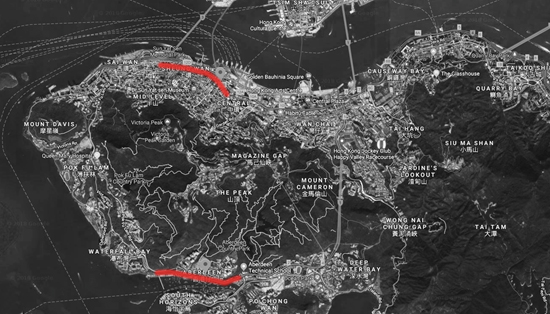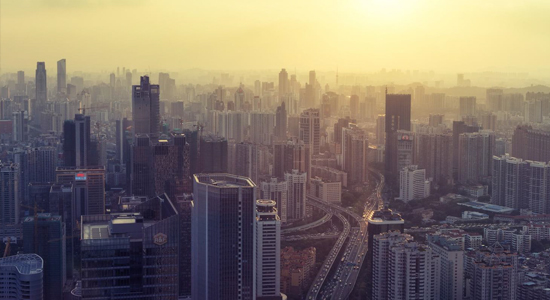Programme 2018-2019
In the academic year 2018-19, the M.Sc. in Urban Design programme will continue its focus on public spaces related to infrastructure and borders. The first studio is aligned to the citizen movement Des Voeux Road Central (DVRC) as an initiative to retake Hong Kong 's roads as spaces for public life. Students will develop proposals for the redesign of Des Voeux Road and Aberdeen Praya to recapture their cultural significance and role as social spaces. Thus the studio uses the opportunities resulting from the construction of the new MTR lines and the Wan Chai Bypass. The second studio focuses on the Zhuhai-Macau border space. With the new Hong Kong, Macau, Zhuhai bridge and new rail infrastructure the spaces around the Zhuhai-Macau border are transforming significantly. The studio aims to use these changes to bring more community benefits for residents and visitors in both cities.
The learning activities in the MSUD programme are co-organized with regional and international partners offering a range of opportunities to experience different urban conditions and interact with students and teachers from different backgrounds. The first studio begins with a "boot camp" co-organized with Stanford University. Later during the term students will meet students and teachers from National Taiwan University and visit community projects in Taipei and Keelung. The second studio is organized in partnership with four leading Mainland Universities to engage with the broader region of the Pearl River Bay Area. The programme's International Summer Workshop will be co-organized this time with colleagues from the New School and give students the opportunity to study related urban design projects in New York.
Term 1:

URBAN DESIGN STUDIO I:
RETAKING THE STREETS
Des Voeux Road & Aberdeen Praya
Hong Kong is celebrated for one of the most efficient and used public transport systems. However, of all modes or moving around the city the design for street space still prioritizes road based vehicular traffic. In the view of implementing UN Habitat's New Urban Agenda, to create an inclusive, socially just, livable and healthy city, street spaces are of essential importance as the most accessible public spaces. In addition, streets are important for a vibrant local economy and street culture.
The aim of studio is to retake the streets as the essential public spaces of the city by improving their walkability. The first studio of the MSUD programme focuses on two main arterial spaces on Hong Kong Island: Aberdeen Praya and Des Voeux Road. The redesign of these street spaces is seen as the starting point to regenerate the surrounding neighbourhoods.
Both streets had important roles for Hong Kong's history and face similar current challenges: Aberdeen Praya was the main artery of the first fishing village in the south of the island, which predated the foundation of the colonial city. DVR dates back to the early time of the colony. It was created with land reclamations as the main east-west spine of the trading and financial center of the city.
With their current road design they act as dividers between the historical districts and the harbor. They are highly polluted and unsafe to walk. In the case of Des Voeux Road thus a citizen movement was formed and fights for the (partly) pedestranization of the street.
Instructor: Associate Professor Hendrik Tieben, Adjunct Assistant Professor Casey Wang
(Read the course description here as PDF)
Term 2:
URBAN DESIGN STUDIO II:
Cross Border Lab:
Reframing the Urban Edge – ZHUHAI X MACAU

Building on the investigation of infrastructure and public space in the first Studio, the second Studio expands in scope to the Pearl River Bay Area. This presents an opportunity to examine the interface between regional infrastructure and local placemaking initiatives. It is a place of complex border relationships, diverse local identities, and intense urban development.
Border areas present an intensified territory for urban design. They are interfaces between cultures and expressions of identity. The border between Zhuhai and Macau provides a case as an urban border that is not the manifestation of a divided city but rather two distinct cities. Under the theme of Cross-Border Lab, the studio will use the Zhuhai / Macau border as a territory to explore the urban potential of the interface between these cities, reframing the urban edge as a place of intensified urban experience and quality of life.
The studio will begin with a study of the territory in its current condition and context and propose of a series of innovative urban interventions for its future development. Students will have the opportunity to focus on one of three areas: old town integration, infrastructural urbanism, new town design. Case sites will be selected along the border to address issues ranging from blue and green infrastructure, inclusive public space and livability, to urban infrastructure design and urban regeneration. The studio will collaborate with leading Chinese urban design and planning schools through the semester as part of wider research and design project relating to the border areas. The studio will have the support and collaboration of Macau-based CURB Center for Architecture and Urbanism.
Instructor: Adjunct Assistant Professor Darren Snow, Adjunct Assistant Professor Nuno Soares
Workshop Inputs: Adjunct Associate Professor Daniel Pätzold